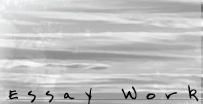|
Essay On Robert Sund’s “There Is No
Exile Where The Heart Is Pure”
Robert Sund’s poem for Pablo Casals is a sympathetic look
at an incredible artist in exile, not only from his war-torn homeland,
but from America’s scared shores as well. The poem is elevated
from a simple farm scene to a symbolic and sympathetic portrait
of Casals through a shift in imagery in the first stanza. This turning
point clues us in to pay close attention to the images that will
help us understand the poem.
Sund starts the poem by putting us in a time and a place, behind
the barn in the first week of March. He puts us near a tree and
a horse seeming to come to life after a long winter. The next line
completes the first stanza and is a radical shift in imagery. It
focuses in on a group of ants and lets us know this is not just
a poem about a barn or a horse. The ants are “calling home
their old senators who/ have failed utterly. / Coming home, carrying
suitcases full of noise/ they pass through small American towns.”
The shift in attention to the ants, and the particular image of
the senators coming home, becomes the key that help unravel the
imagery of the rest of the poem.
Sund clearly names the senators in the poem as American. The history
of when the poem was written suggests that these senators are McCarthy
and others who led the anti-Communist witch-hunts in the 1950s.
The poem’s language denounces the actions of this era as a
direct failure of the senators towards their constituents. The ants,
the common working people in small-town America, have been misled
by “suitcases full of noise.”
This understanding brings richness to the other images Sund offers
us in the rest of the poem. The rusted nails that bleed conjure
so much pain, both the blood that Casals surely experienced in the
Spanish Civil War, and the “red scare” in America that
kept Casals from being able to play here after he left Spain.
The bleeding nails also conjure Christ-like images. Casals, like
Christ, has become isolated by the sacrifice of his lost connection
to Spain.
Sund seems full of sympathy in the poem, and not just for Casals.
We enter the poem after the horror, when winter is almost over.
The actions of the senators are done, they are recalled. The horse,
Christ-like Casals, is raining down “little pieces of cedar”,
his divine music, to the ants in their disappointment and struggle.
The image of the old winter horse playing unaccompanied shows us
the power of Casals music. It is like a gift to the ants. It shudders
the barn and spills the seeds of life down to meet the earth.
It is in the last two stanzas that we begin to understand Sund’s
sympathy for the whole scene. Sund has left the barn and the horse
mostly to the reader’s imagination, we don’t have a
sense of being grounded in the barn, just vague odors and dampness.
And suddenly appears a hand, “blue ridges and rivers…rests
on the white sheet of the windows.” This sudden angelic vision
summons up a landscape for us, and presumably, the horse and the
unseen narrator who is watching the scene. This landscape is fresh
and pure. Blue and white are the mood, and the image seems to suggest
quite a bit of dazzling light. There in the musty isolation and
loneliness, a divine hand appears.
The last stanza brings sympathy for the whole scene. A maternal
figure enters the dark of the barn, the unseen narrator’s
grandmother. When grandmother brings “healing sunlight”
to this unlit place, we are lit by the light as well. Sund’s
sympathy extends to us too. Grandmother seems to put into context,
the “drifting continents” of the doors and brings a
maternal comfort to the poor beast in exile. This image seems to
carry the purity the image of the title suggests. Casals playing
his music in exile is comforted by something otherworldly and perhaps
divine. Because his heart is pure and dedicated to his art, he becomes
the nurturer, like Christ, to all of us. Can anyone giving so much
of himself truly be alone?
|

